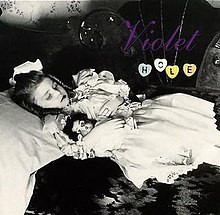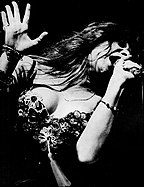
Hole was an American alternative rock band formed in Los Angeles, California, in 1989. It was founded by singer Courtney Love and guitarist Eric Erlandson. It had several different bassists and drummers, the most prolific being drummer Patty Schemel, and bassists Kristen Pfaff and Melissa Auf der Maur. Hole released a total of four studio albums between two incarnations spanning the 1990s and early-2010s and became one of the most commercially successful rock bands in history fronted by a woman.

Celebrity Skin is the third studio album by American alternative rock band Hole, released on September 8, 1998, in the United States on DGC Records and internationally on Geffen Records. It was the last album released by the band before their dissolution in 2002. Hole intended for the record to diverge significantly from their previous noise and grunge-influenced sound as featured on Pretty on the Inside (1991) and Live Through This (1994). The band hired producer Michael Beinhorn to record Celebrity Skin over a nine-month period that included sessions in Los Angeles, New York City, and London. It was the band's only studio release to feature bassist Melissa Auf der Maur. Drummer Patty Schemel played on the demos for the album but was replaced by session drummer Deen Castronovo at the suggestion of Beinhorn. This issue created a rift between Schemel and the band, resulting in her dropping out of the tour and parting ways with the group, though she was still credited.
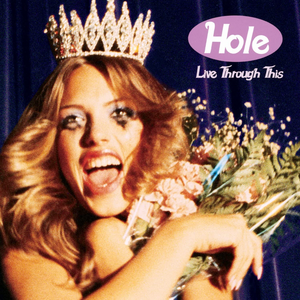
Live Through This is the second studio album by the American alternative rock band Hole, released on April 12, 1994, by DGC Records. Recorded in late 1993, it departed from the band's unpolished hardcore aesthetics to more refined melodies and song structure. Frontwoman Courtney Love said that she wanted the record to be "shocking to the people who think that we don't have a soft edge", but maintain a harsh sensibility. The album was produced by Sean Slade and Paul Q. Kolderie and mixed by Scott Litt and J Mascis. The lyrics and packaging reflect Love's thematic preoccupations with beauty, and motifs of milk, motherhood, anti-elitism, and violence against women, while Love derived the album title from a quote in Gone with the Wind (1939).

Pretty on the Inside is the debut studio album by American alternative rock band Hole, released on September 17, 1991, in the United States on Caroline Records. Produced by Sonic Youth's Kim Gordon, and Gumball frontman Don Fleming, the album was Hole's first major label release after the band's formation in 1989 by vocalist, songwriter, and guitarist Courtney Love and lead guitarist Eric Erlandson.

"Be a Man" is the thirteenth and last single by alternative rock band Hole before their breakup in 2002.
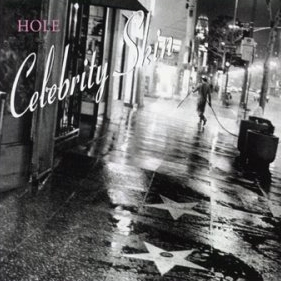
"Celebrity Skin" is a song by American alternative rock band Hole, released on August 31, 1998 as the first single from their third studio album of the same name. It is their most commercially successful single, being the only one to reach the top place on the US Modern Rock Tracks chart. In October 2011, NME ranked it the 126th best track of the past 15 years.
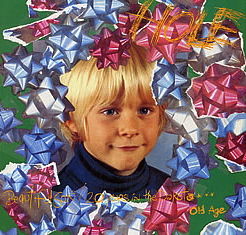
"Beautiful Son" is a song by American alternative rock band Hole, co-written by frontwoman Courtney Love, lead guitarist Eric Erlandson, and drummer Patty Schemel. The song was released as the band's fourth single in April 1993 on the European label City Slang. To coincide with the song's lyrics, Love used a photograph of her husband, Kurt Cobain, at age 7 as the single's artwork.

My Body, the Hand Grenade is the first and only compilation album by American alternative rock band Hole, released on October 28, 1997, through the band's European label, City Slang Records. It was also imported for sale in the United States, where it was released on December 10, 1997. The album was compiled with the intent of tracking the band's progression from their noise rock beginnings to the more melodic songwriting that appeared on their second album, Live Through This (1994).
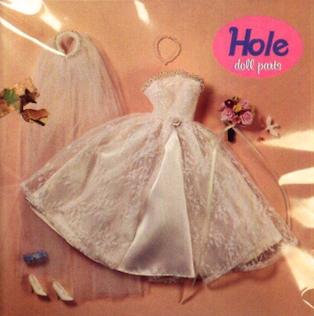
"Doll Parts" is a song by American alternative rock band Hole, written by vocalist and rhythm guitarist Courtney Love. The song was released as the band's sixth single and second from their second studio album, Live Through This, in November 1994 to accompany the band's North American tour. It was also the first single to be released following the death of bassist Kristen Pfaff in June 1994.

"Malibu" is a song by American alternative rock band Hole. It is the fourth track and second single from the band's third studio album, Celebrity Skin, and was released in December 1998, on DGC Records. The song was written by vocalist and rhythm guitarist Courtney Love, lead guitarist Eric Erlandson and Billy Corgan of the Smashing Pumpkins, who contributed to four other songs on Celebrity Skin.

"Retard Girl" is the debut single by American alternative rock band Hole, written by vocalist and guitarist Courtney Love, and released in April 1990 by Sympathy for the Record Industry. Recorded in March 1990, the single was produced by Love's then-husband, James Moreland. Drawing on the influence of no wave and noise rock bands of the time, the song features distorted guitars, heavy bass, and unpolished, aggressive vocals.
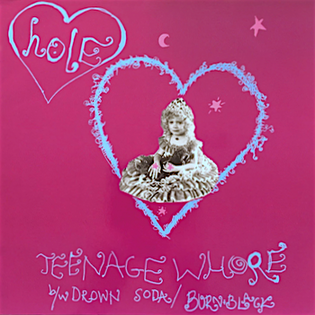
"Teenage Whore" is a song by American alternative rock band Hole. It is the first track on the band's debut studio album, Pretty on the Inside (1991), and was released as a single in the United Kingdom on the European label, City Slang in September 1991. The single was released in both compact disc as well as 12" and 7" vinyl, with "Drown Soda" and "Burn Black" as b-sides. Though it did not chart in the United States, the single gained popularity in the United Kingdom upon its release, peaking at #1 on the UK Indie Chart in September 1991.

"Softer, Softest" is a song by American alternative rock band Hole, written by frontwoman Courtney Love and lead guitarist Eric Erlandson. The song was released as the band's eighth song and fourth and final single from their second studio album, Live Through This, in December 1995. The single was released just as the band finished their extensive touring in 1995.

"Awful" is a single by American alternative rock band Hole from the band's third studio album, Celebrity Skin. Released in April 1999 by Geffen Records as a CD single, the song's lyrics explore how the media and modern pop culture corrupt young girls and how they should rebel against this. The line "swing low, sweet cherry" in the song is an allusion to the African American spiritual hymn, "Swing Low, Sweet Chariot".

The discography of Hole, a Los Angeles–based American alternative rock band, consists of four studio albums, one compilation album, three extended plays, and 16 singles.

Nobody's Daughter is the fourth and final studio album by the American alternative rock band Hole, released on April 23, 2010, by Mercury Records. The album was initially conceived as a solo project and follow-up to Hole frontwoman Courtney Love's first solo record, America's Sweetheart (2004). At the urging of her friend and former producer Linda Perry, Love began writing material while in a lockdown rehabilitation center in 2005 following a protracted cocaine addiction and numerous related legal troubles. In 2006, Love, along with Perry and Billy Corgan, began recording the album, which at that time was tentatively titled How Dirty Girls Get Clean.
"Asking for It" is a song by the American alternative rock band Hole. It is the fourth track on the band's second studio album, Live Through This, released on April 12, 1994 on Geffen Records. The song was written by vocalist and rhythm guitarist Courtney Love and lead guitarist Eric Erlandson.
"Turpentine" is a song by the American alternative rock band Hole. It was written by vocalist and rhythm guitarist Courtney Love and lead guitarist Eric Erlandson. The song was one of the band's first compositions and remained unreleased for seven years before being released on the band's second EP, The First Session on August 26, 1997. Although not as well known as Hole's later songs, "Turpentine" is a notable song for the band as it is often cited as "the first Hole song."
"Garbadge Man" is a song by the American alternative rock band Hole, written collectively by the band's original line-up. It is the third track on the band's first studio album, Pretty on the Inside, released on September 17, 1991, by Caroline Records. Dealing with religious and personal issues, "Garbadge Man" was Hole's first song to have a music video, which was broadcast on 120 Minutes on MTV several times in the early 1990s.
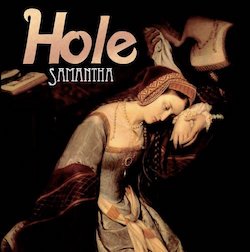
"Samantha" is a song by the American alternative rock band Hole. It is the fifth track on the band's fourth studio album, Nobody's Daughter, released on Mercury Records on April 23, 2010. Written by vocalist Courtney Love, The Smashing Pumpkins frontman Billy Corgan and music producer Linda Perry, "Samantha" was originally planned as the album's lead single. "Skinny Little Bitch" was later released as the album's lead single on March 12, 2010, and "Samantha" did not receive a single release reputedly due to the controversy over its composition.
